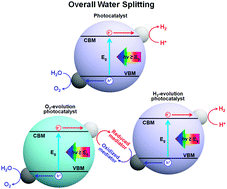Recent developments in heterogeneous photocatalysts for solar-driven overall water splitting
Abstract
Overall water splitting based on particulate photocatalysts is an easily constructed and cost-effective technology for the conversion of abundant solar energy into clean and renewable hydrogen energy on a large scale. This promising technology can be achieved in a one-step excitation system using a single photocatalyst or via a Z-scheme process based on a pair of photocatalysts. Ideally, such photocatalysis will proceed with charge separation and transport unaffected by recombination and trapping, and surface catalytic processes will not involve undesirable reactions. This review summarizes the basics of overall water splitting via both one-step excitation and Z-scheme processes, with a focus on standard methods of determining photocatalytic performance. Various surface engineering strategies applied to photocatalysts, such as cocatalyst loading, surface morphology control, surface modification and surface phase junctions, have been developed to allow efficient one-step excitation overall water splitting. In addition, numerous visible-light-responsive photocatalysts have been successfully utilized as H2-evolution or O2-evolution photocatalysts in Z-scheme overall water splitting. Prototype particulate immobilization systems with photocatalytic performances comparable to or drastically higher than those of particle suspension systems suggest the exciting possibility of the large-scale production of low-cost renewable solar hydrogen.

- This article is part of the themed collection: Advances in Solar Energy Conversion


 Please wait while we load your content...
Please wait while we load your content...